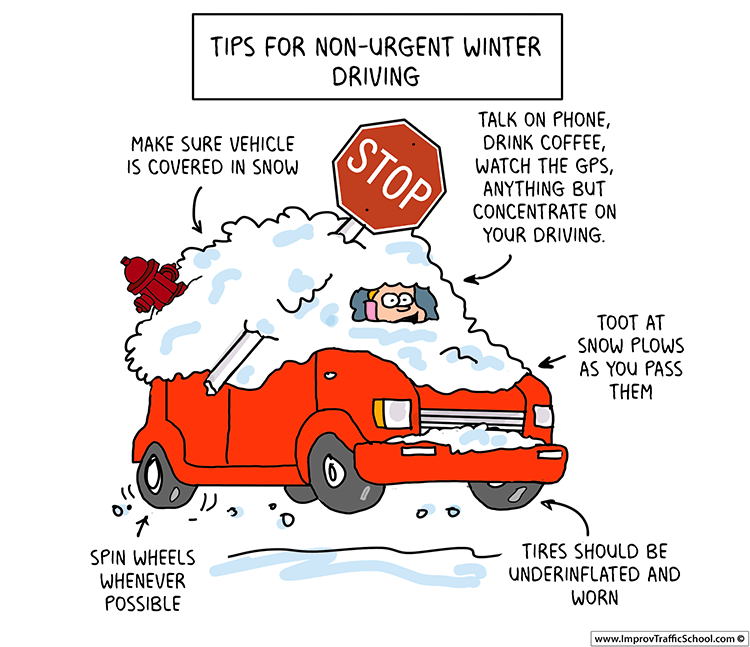Santa doesn’t just know if you’ve been naughty or nice this year.
He also knows if you’ve been driving safely or not. Mmmhm, that’s right: he knows if you’ve gone a bit over the speed limit in a mad dash to get to work because you slept through your alarm clock after hitting the snooze button thirteen or fourteen times in a row.
Santa and his dutiful elves were nice enough to clue us in on these seven little-known and frequently-misunderstood myths about driving in the winter weather. And he’d like to clue you in on some of them to make you a better driver. This year, you’ll be better prepared to tackle the roads while you’re out dropping $100’s for the perfect gifts for grandma Flo and aunt Gertrude.
So without further ado, let’s look at the top seven winter driving myths, DEBUNKED:
Myth 1: If your car skids or slides on the ice, put it in neutral to control it.
Reality: Neutral doesn’t actually do anything, so putting your car into neutral won’t — you know — actually do anything. And when your car does stop skidding, you’re going to want to use the gas pedal. If your car starts sliding across the ice like it’s some kind of seriously unbalanced figure skater, don’t hit the brakes, and don’t panic. Instead, ease off the gas and direct your wheels to match the direction that the rear of your car is already sliding in. And remember — Santa knows if you’re driving too fast on the ice!
Myth 2: Under-inflated tires do better in the winter weather because they can gain more traction.
Reality: Tires that are under-inflated will actually unbalance your car when you make turns. It’s the same as distributing the weight of the vehicle to the right or left as you make a right or left turn.
Myth 3: If you warm your car up, it’ll help it perform better in the cold weather.
Reality: Your car is quite tolerant of the cold — it doesn’t need to be warmed up before it’s taken for a drive through the town or highway. However, you’ll sure perform better if you’re not shivering half to death.
Myth 4: When driving in the snow and ice and other nasty stuff, drive in the grooves on the road that were made by other drivers.
Reality: If there are grooves being formed in the snow by other vehicles, that’s snow that’s fallen over ice. So you’d actually be driving over slippery snow and ice. If you notice a lot of grooves, try to switch lanes to avoid driving through the snow-packed ice.
Myth 5: All-wheel drive basically makes my car invincible.
Reality: While all-wheel drive is pretty awesome, it doesn’t make any vehicle invincible. If you hit the brakes on an icy road, all four wheels will go into lock-up mode. And when your wheels are locked up, it makes it incredibly difficult to steer. A two-wheel drive vehicle and an AWD vehicle will react almost exactly the same way when slipping around on the icy roads.
Myth 6: Only two winter tires are necessary.
Reality: The opposite is true; having only two winter tires on your car can do more harm than good. If a pair of winter tires are installed on the rear of a rear-wheel drive vehicle, you will be able to accelerate just fine, but steering and stopping will both suffer. It’s the ability to steer and stop your car that keeps you out of harm’s way. Drivers with winter tires on the front of their front-wheel drive vehicles might feel safe, but a similar scenario is true. This setup will allow drivers to accelerate and steer fine, but the rear of the vehicle will have very little traction (especially when compared to the front), causing an imbalance. It’ll increase the odds of a rear-end skid, which can lead to losing control if there’s ice or snow on the road.
Myth 7: Winter tires don’t help you if you live in the city.
Reality: There might be less snow to deal with in the city, but winter tires aren’t just for long excursions or for country drivin’. Winter tires are designed with a special tread that will keep your car moving smoothly, no matter what the conditions are. Not to mention that city streets can develop quite a build-up of snow around cars parked in the street along the meters, and that slush and ice can form really fast in the bitter cold weather. Winter tires are designed with a specialized tread compound that will better grip the cold winter roads.
If you promise to drive safely in the winter weather this holiday season, we promise Santa will put you on his “nice” list this year.

 Live Chat
Live Chat







